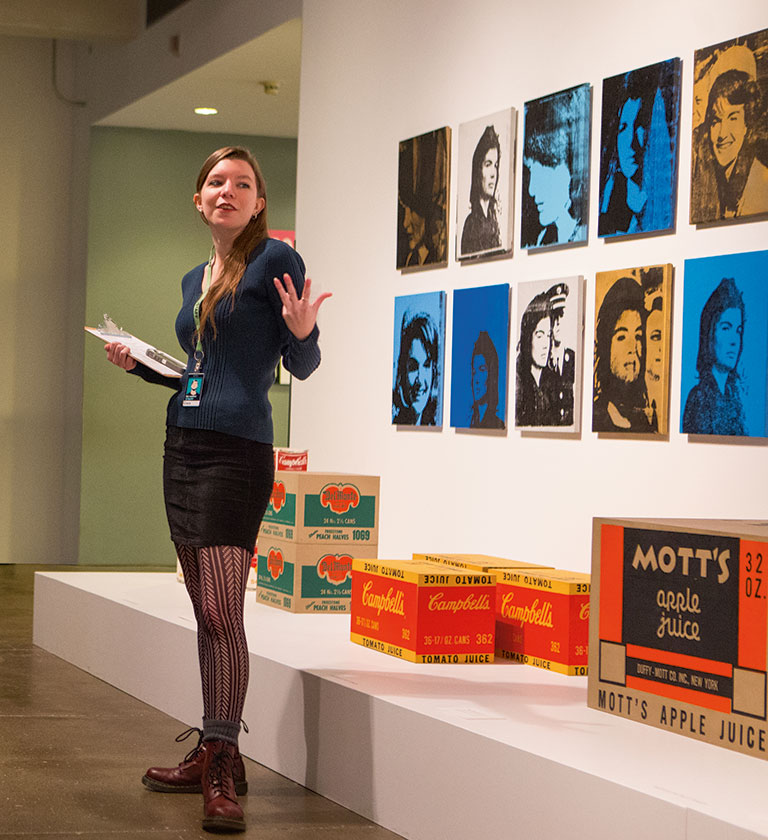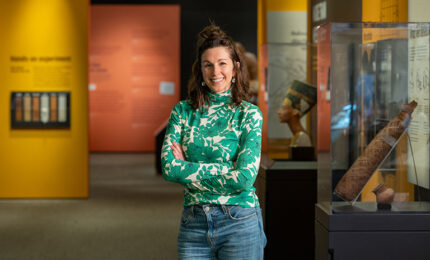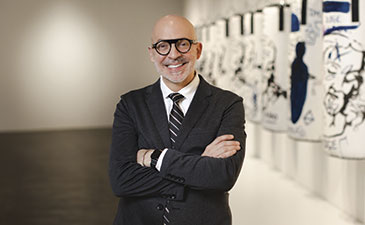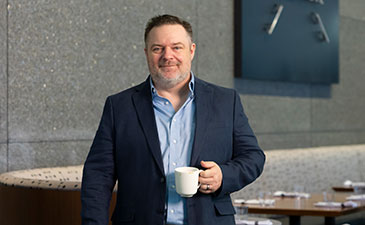
Grace Marston wants to be the preeminent Andy Warhol scholar of her generation. A 32-year-old Pittsburgh native, Marston first dove into Warhol’s work as a middle school student in Maryland. Years later, while taking a break from college in 2011, she returned to Pittsburgh and pursued her interest in the late Pop icon by taking a job as a gallery attendant at The Andy Warhol Museum, where she continues to share her expertise as an arts educator by teaching courses, presenting lectures, and giving tours. Marston, who expects to graduate from the University of Pittsburgh this year with a bachelor’s degree in History of Art and Architecture, says she wants to show others how Warhol’s art can connect some of the most complex topics and social movements in history.
Q: How did you get interested in Warhol?
A: In seventh grade, I wrote a research paper and made a documentary video about Warhol. I was born in Pittsburgh, but I was living in Maryland at the time, so I partially chose the topic as an excuse to come to Pittsburgh to visit the museum. I did research in the basement of The Warhol, and now I help middle schoolers with their research projects, so it’s come full circle!
Q: What about Warhol makes you feel so connected with his work?
A: Warhol is a gateway to all these different avenues of research and learning. It’s not just about Warhol, but about how he intersects with all these different topics. I love researching the Iranian Revolution, for example, or the political situation in Italy in the ‘70s that led to Warhol’s Hammer and Sickle paintings. I have far-left politics myself, but I’m interested in this artist who’s so associated with capitalism and American consumerism. With my thesis, I’m exploring this question of the ways in which a socialist can enjoy Andy Warhol.
Q: So, how does a socialist enjoy Warhol?
A: You can interpret his ’60s Pop paintings as critiques of capitalism. The fact that wealthy capitalists bought them showed that he was telling a joke that they weren’t quite in on. Then, in the ’70s, when he started taking on more blatantly communist themes like Chairman Mao or the hammers and sickles, it reflects that communism became easier to find during the détente era, since he could take those subjects on without worrying about persecution. We can enjoy this irony that Warhol was playing with.
Q: How do you make Warhol relevant today?
A: I don’t think it’s that challenging. He’s painted celebrities that are still famous today and predicted a lot of qualities of consumerism, fame, and celebrity culture. In late 2015, after Donald Trump announced his presidential run, I checked Andy Warhol’s diaries for encounters between Andy Warhol and Donald Trump and uncovered this story where Trump commissioned Warhol to do paintings of Trump Tower and then he didn’t end up buying any of the paintings because he didn’t like the colors Warhol used. Warhol was really mad and was talking smack about Trump in the diaries. It was really funny. I did a blog post about that, and it got picked up by a bunch of major news publications including CNN and The New York Times. It was cool to see so many people respond to that story.
Q: What are some of your favorite things you’ve experienced at the museum?
A: One cool thing I’ve done is an initiative for more queer programming. I’ve done a lot of research on Warhol’s boyfriends and the different ways that his boyfriends would show up in his artwork and impacted his career. I helped develop this curriculum that then became the Dandy Andy Tour, which is all about investigating the queer themes in his art. That’s been really rewarding.
Q: Could you tell us a little bit about the “Collection Close-Ups” you do?
A: A lot of other arts educators have been making videos about Warhol’s studio practice. I’m definitely more interested in art history and storytelling, so I thought I should make a different type of video. I’ve only done one so far, about the elephant painted by Keith Haring that you see on the fourth floor right now. It had a first life as part of the Met Costume Institute, and then a second half life as an unfinished artwork by Basquiat and Victor Hugo, then Keith Haring brought it into its final form. You wouldn’t know that from just looking at the elephant. I thought that was a good story to start off the Collection Close-Up initiative.
Q: Do you ever think about what Warhol would think about the museum?
A: His first question would probably be why it was in Pittsburgh, but he has no idea how much Pittsburgh has changed. I would hope he would be proud of what Pittsburgh has become.






